Synchron Prime Edition
Introduction
Welcome to the Vienna Symphonic Library’s series of Synchron Instruments! The instruments were recorded at Stage A, the main hall of Vienna’s revitalized Synchron Stage Vienna. The recordings were executed using an expansive, phase-controlled multi-microphone set-up, capturing orchestral instruments played in a scoring stage with exceptional acoustics, now ready to be used in your studio. This document will provide you with the information you need to use the Library with our Vienna Synchron Player.
Each of the Library's instruments features Room-Mix samples (distilled from the complex microphone setup of our large collections' recordings) and those of a Close microphone, allowing you to adjust placement and balance of your instruments in the Synchron Player's "Mix" tab.
About Presets
The library offers three basic Preset types for every instrument in their respective folders, marked “Velocity”, “VelXF - MOD”, and “VelXF sus - MOD”. In the regular “Velocity” presets, note volume is controlled by keystroke velocity just like a piano. In “VelXF” Presets, all articulations have velocity crossfading activated so that you can control dynamics with MIDI controller CC1, the modwheel. In “VelXF sus - MOD” Presets, however, velocity crossfading is only activated for long notes, while the dynamics of short notes are controlled by keystroke velocity, thus facilitating phrasing. Velocity crossfading can be enabled or disabled by clicking its on/off symbol in the Synchron Player's Perform tab.
The Presets of each instrument group are subdivided into different articulation categories, including one (provided there are enough articulations) named “Custom” and ready for your own creations. Within these articulation categories, you can select a type, e.g., bold or agile staccato, and for some of the types there are additional options available, such as crossfading between normal and tremolo articulations. If you happen to be short of RAM, you can deactivate Articulations you do not need, and activate them again if necessary.
Switching between an instrument’s playing styles and articulations is generally done via dedicated keys on the keyboard and aptly called “keyswitches”. By default the keyswitches for Articulations are mapped depending on an instrument’s range – starting from C1 (for Middle C = C4) for higher instruments, and C5 for low ones. The Type keyswitches normally start from C2 for high instruments, and from C6 for low ones.
Dimension Controllers offer additional options within some Articulations or Types, most notably that of crossfading between different Patches. The controller function is indicated by the group’s respective caption, as of course it may take on different tasks as needed.
About Mixer Presets
For each instrument, there are a number of Mixer Presets that depict different recording situations. The basic Mixer Presets are Close, Classic, Wide, Distant, and Ambience; others like Lush, Sparkling, or Catchy may be added, which are tailored to the respective instrument.
About Patches
Patches can be used to build your own custom Presets and adapt the Synchron Libraries to your specific requirements. For further information on constructing Presets, please see the Synchron Player manual.
About Pitch
For designating pitch, the Vienna Symphonic Library uses International Pitch Notation (IPN), which was agreed upon internationally under the auspices of the Acoustical Society of America. In this system the international standard of A=440 Hz is called A4 and middle C is C4. All pitches are written as capital letters, their respective octave being indicated by a number next to it. The lowest C on the piano is C1 (the A below that is A0), etc.
The Synchron Player software allows you to set middle C to C3, C4, or C5 according to your preference.
Selecting another setting than C4 will of course also change the play ranges and keyswitches accordingly.
Strings + Harp
Harp
- Regular and harmonics
- Range: B0–G#7
- Articulation switches: A0/A#0
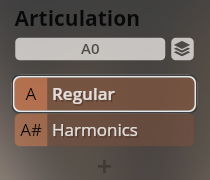
String ensembles
There are 1st and 2nd violins, violas, cellos, and double basses, as well as two “tutti” presets.
Instrument ranges
- 1st Violins G3–G7
- 2nd Violins G3–E7
- Violas C3–F6
- Cellos C2–A5
- Double Basses B0–D4
- Some articulations may not comprise the full range.
Articulation switches: violins, viola, cello C1–G1, double basses C5–G5.
Tutti Presets
There are two special Presets containing all string ensembles. These are especially useful for quick layouts and, e.g., for playing an entire string orchestra live. The Presets are a full range and a compressed range version.
- Strings – Tutti full range. Mapping range: B0–D7
- Basses B0–B2
- Cellos C2–B3
- Violas C3–F#4
- 2nd violins C4–D7
- 1st violins G3–D7
- Strings – Tutti compressed range. Mapping range: C1–D6
- Basses C1–B2
- Cellos C2–B3
- Violas C3–B3
- 1st and 2nd violins C4–D6
The keyswitches for these tutti Presets are F7–G#7 for types/attack, and B7/C8 for release variants.
Short Notes
- Staccato bold and agile
- Bold/Agile: C2/C#2, C6/C#6
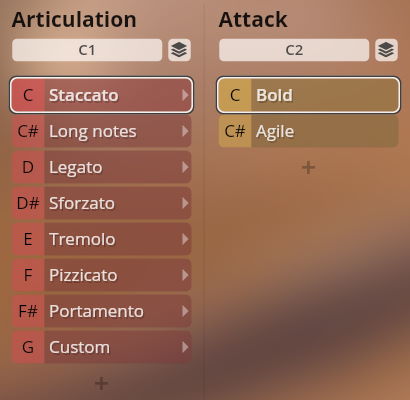
Long Notes
Long notes with normal and soft attack and release, marcato, and with tremolo crossfading.
- Type switches: C2–D#2, C6–D#6
- Release normal/soft: F2/F#2, F6/F#6
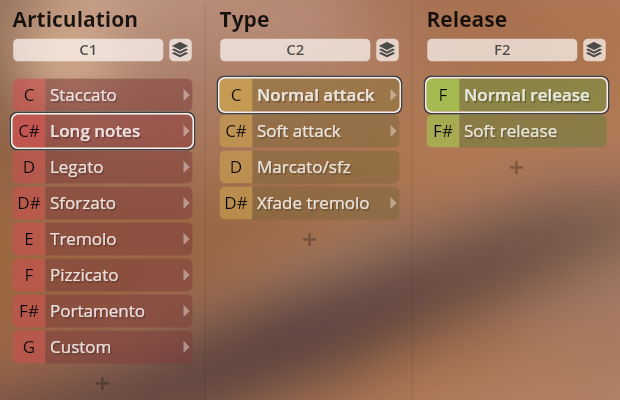
XFade tremolo
Use Dim.Ctrl/A (CC3) to crossfade between normal sustains and tremolo.
- Type switches: C2–D#2, C6–D#6
- XFade tremolo: Dim.Ctrl/A (CC3)
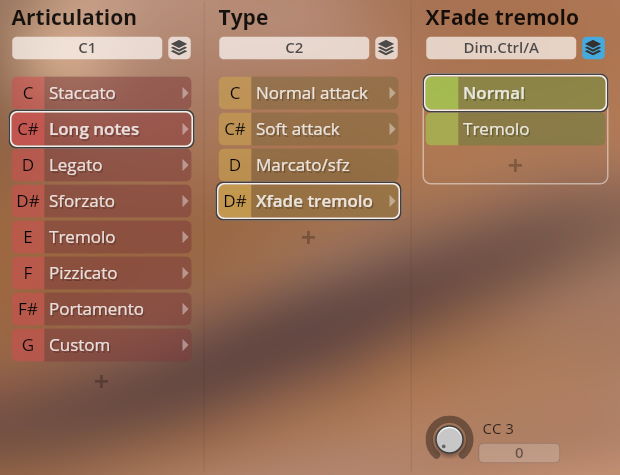
Legato
Legato with normal and soft attack and release, as well as with marcato starting notes.
- Attack switches: C2–D2, C6–D6
- Release normal/soft: F2/F#2, F6/F#6
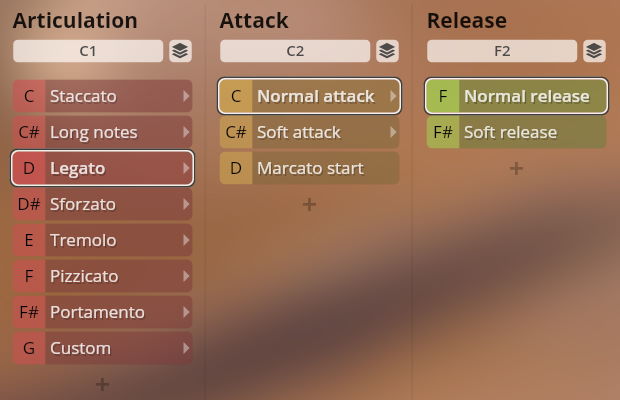
Sforzato
Sforzato, regular and with a tremolo crossfading option.
- Type switches: C2/C#2, C6/C#6
- XFade tremolo: Dim.Ctrl/A (CC3)
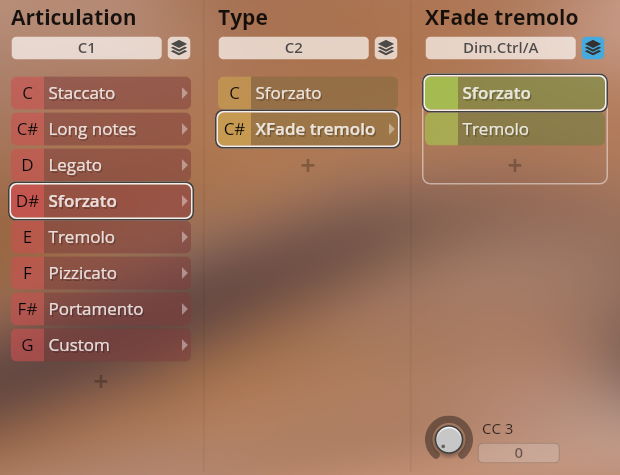
Tremolo
Tremolo regular and with marcato attack. Use Dim.Ctrl/B (CC4) to adjust the strength of the marcato attack.
- Type switches: C2/C#2, C6/C#6
- Marcato attack: Dim.Ctrl/B (CC4)
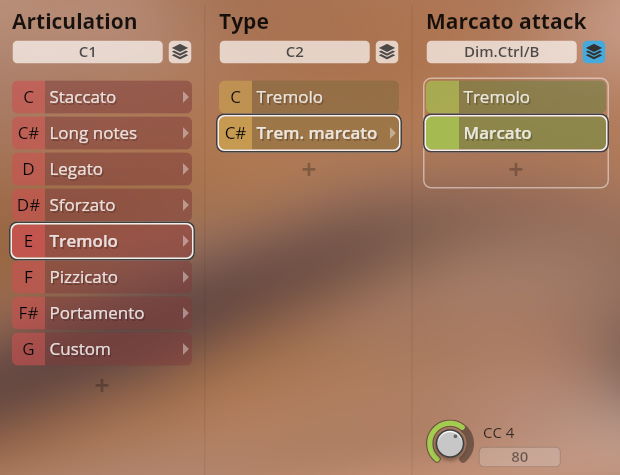
Pizzicato
Pizzicato and snap pizzicato.
- Type switches: C2/C#2, C6/C#6
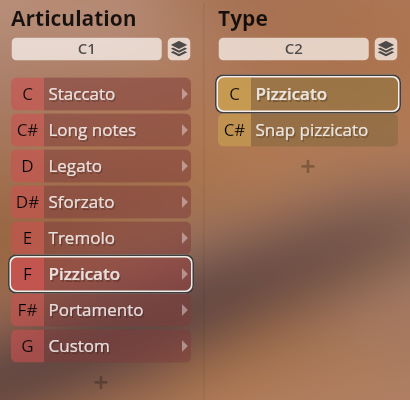
Portamento
Portamento with normal and soft attack and release, as well as with marcato starting notes.
- Attack switches: C2–D2, C6–D6
- Release normal/soft: F2/F#2, F6/F#6
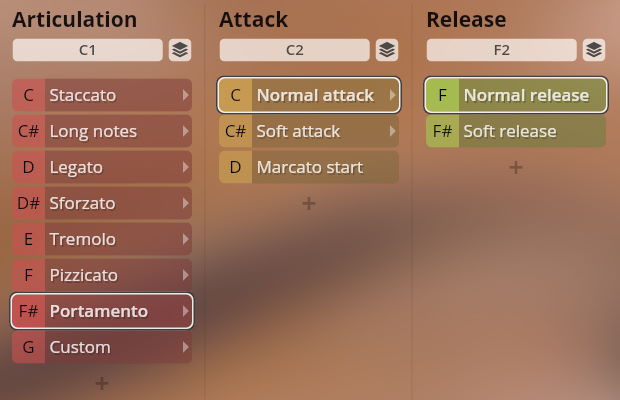
Woodwinds
The orchestral woodwinds in this collection have largely the same articulations and therefore very similar layouts. The clarinets and contrabassoon do not offer any vibrato variants.
The ethnic instruments (part of the Collection’s expansion published in November, 2023) are listed separately, as they have instrument-typical articulations.
Instrument ranges
- Piccolo: C5–C8
- Flute 1: B3–D7
- Flute 2: B3–C7
- Oboe 1 and 2: A#3–A6
- English Horn: E3–C6
- Clarinet in Bb 1 and 2: D3–G6
- Bass clarinet: A#1–A5
- Bassoon 1: A#1–F5
- Bassoon 2: A#1–D#5
- Contrabassoon: A#0–C4
- Tin Whistle: C5–C7
- Bansuri: D4–D6
- Dizi: G4–G6
- Shakuhachi: C4–D6
Articulation switches: C1–E1
Type switches: starting at C2 / Bassoons C6.
Orchetral instruments
Short Notes
Staccato and portato bold and agile.
- Type switches: C2–D#2, C6–D#6
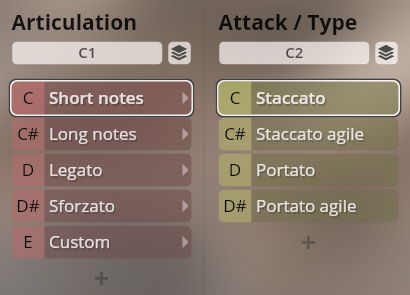
Long Notes / Legato
Sustained notes / performance legato, without and with vibrato. The clarinets have no vibrato option and therefore no additional keyswitches.
With the vibrato crossfading option, use Dim.Ctrl/C (CC20) to control the vibrato amount.
- Vibrato options: C2–D2 / C6–D6
- Vibrato XF: Dim.Ctrl/C (CC20)
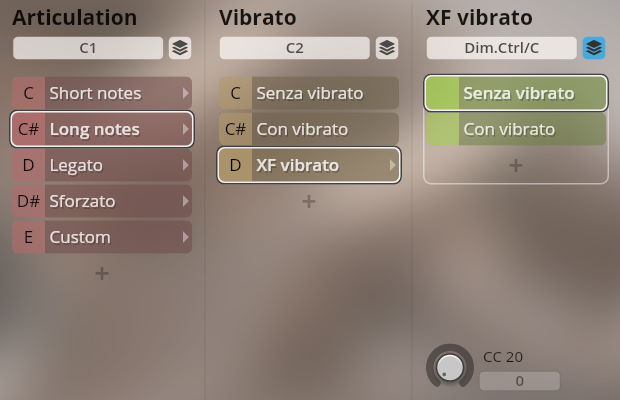
Sforzato
Sforzato and sforzatissimo without and with vibrato.
The piccolo flute does not offer sforzatissimo. The clarinets, bassoon 2, and contrabassoon have no vibrato options.
- Vibrato/Type switches
- piccolo: C2–D2
- flutes, oboes, English horn: C2–F2
- clarinets: C2/D2
- bass clarinet, bassoon 2, contrabassoon: C6/D6
- bassoon 1: C6–F6
- Vibrato XF: Dim.Ctrl/C (CC20)
Piccolo
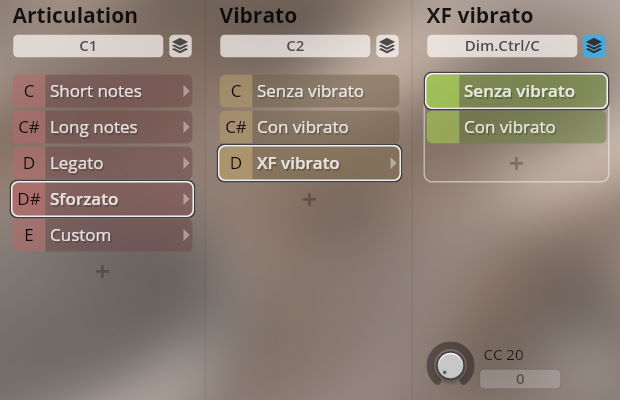
Flutes etc.
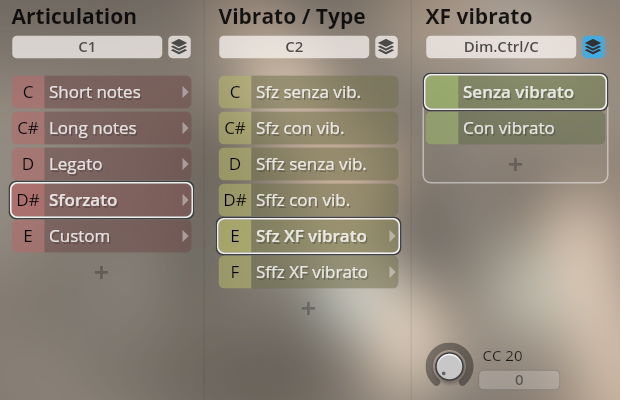
Clarinets etc.
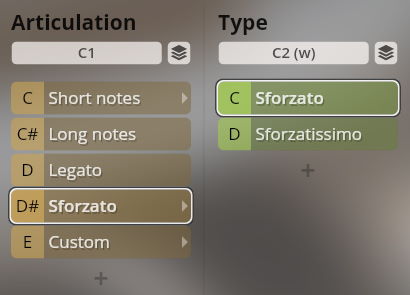
Ethnic instruments
Tin Whistle
Short notes
- Staccato, and portato grace notes
- Type switches: C2/D2
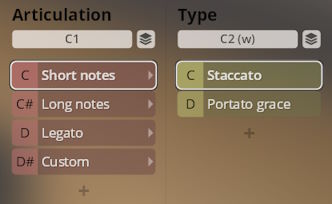
Long notes, legato
- Sustained notes / performance legato, with normal, cut, roll, and glissando attack
- Attack switches: C2–D#2
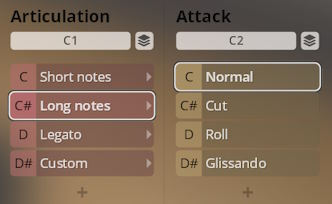
Bansuri
Short notes
- Staccato and short kana
- Type switches: C2/D2
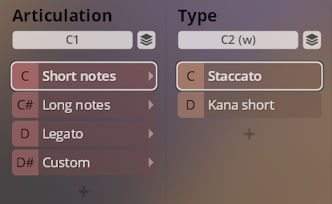
Long notes, legato
Sustained notes / performance legato, normal and kana attack, with normal and falling release.
- Attack switches: C2–C#2
- Release switches: C3–C#3
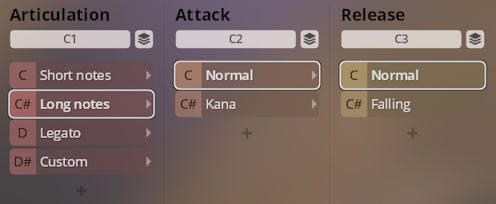
Dizi
Short notes
Staccato and portato notes.
- Type switches: C2/D2
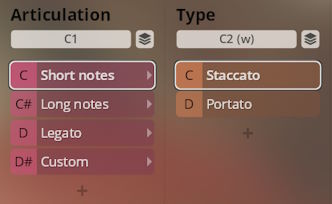
Long notes, legato
Sustained notes / performance legato, normal and gamaka attack, with normal and accented release.
- Attack switches: C2–C#2
- Release switches: C3–C#3
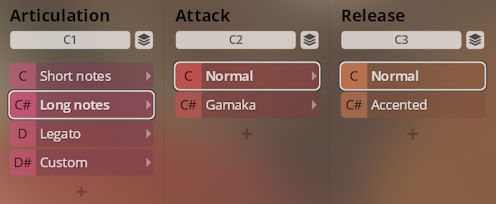
Shakuhachi
Short notes
Staccato and portato effect notes.
- Type switches: C2/D2
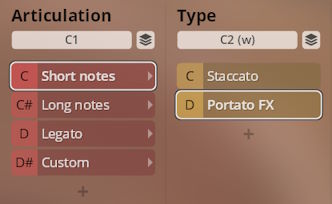
Long notes, legato
Sustained notes / performance legato, with normal and grace note attack, normal and accented release.
- Attack switches: C2–C#2
- Release switches: C3–C#3
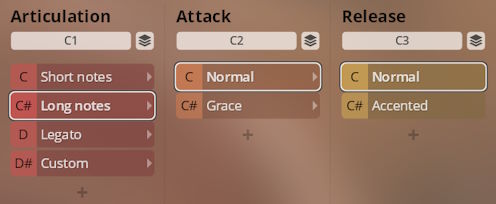
Brass
Like the woodwinds, the brass instruments share most of their articulations and therefore have very similar layouts.
- Instrument ranges
- Trumpet 1 and 2: F#3–D6
- Trumpet ensemble (4): F#3–D6
- Horn 1 and 2: C2–F5
- Horn ensemble-(6): D#2–F5
- Tenor trombone: E2–A#4
- Bass trombone: F1–C4
- Trombone ensemble (4): E2–A#4
- Bass tuba: C1–G4
- Articulation switches: C1–E1; bass instruments: C5–E5
- Type switches: starting at C2 / C6
Tutti Brass
This additional Preset has the three brass sections plus the bass tuba stacked, making it easy to play them in a live setup or use them for quick layouts. Apart from that, the articulations are the same as listed below.
- Ranges
- Bass tuba C2–E3
- Trombones E2–B3
- Horns F3–B4
- Trumpets C4–D6
- Type switches: starting at C7
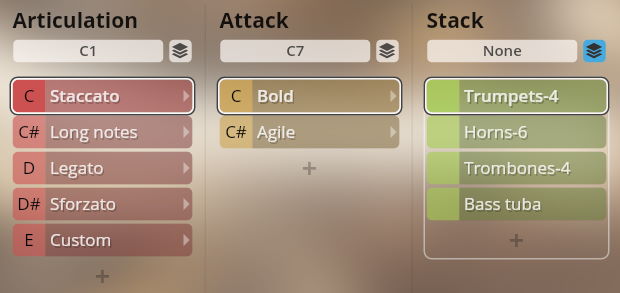
Short Notes
Staccato and portato bold and agile. The ensembles have no portato articulations.
- Type switches: C2–D#2, C6–D#6
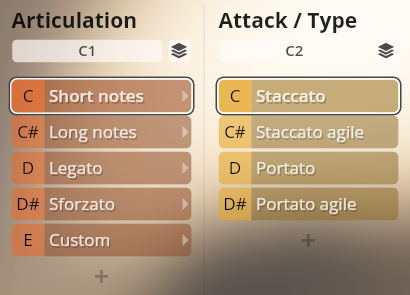
Ensembles
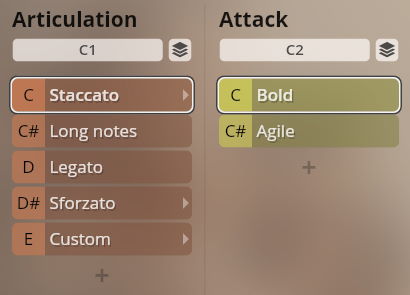
Long Notes / Legato
Sustained notes / performance legato. Only the solo trumpets offer articulations without and with vibrato, the other instruments have no additional keyswitches or other controllers.
With the vibrato crossfading option, use Dim.Ctrl/C (CC20) to control the vibrato amount.
- Vibrato options: C2–D2
- Vibrato XF: Dim.Ctrl/C (CC20)
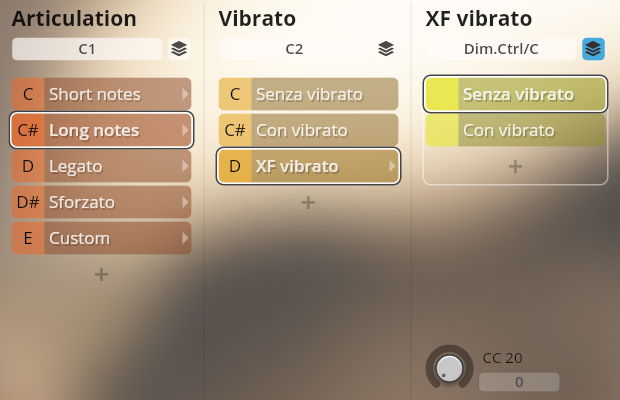
Sforzato
Sforzato and sforzatissimo.
- Type switches: C2–D2, C6/D6
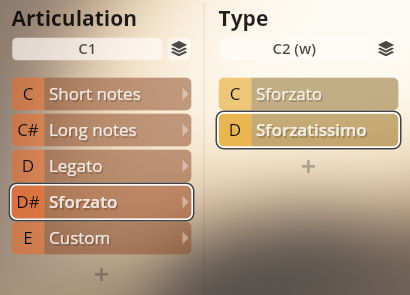
Percussion
Naturally, the percussion instruments – especially unpitched percussion – have the highest variety in articulations. You will often find these different articulations not distributed over several player slots, but mapped over the keyboard of one slot, with similar articulations mapped to the same keys throughout instruments whenever applicable. The instruments are:
- Timpani
- Celesta
- Glockenspiel
- Xylophone
- Tubular bells
- Snare drum
- Bass drum
- Tambourine
- Concert toms
- Taiko
- Piatti
- Suspended cymbal
- Tam-tam
- Triangle
- Woodblocks
The unpitched percussion are also gathered together in an additional Preset called “Unpitched – All”, which can be used for live play (takes some practice, though!) or quick layouts.
Timpani
The Preset contains five stacked timpani sized from 32" to 20" with single strokes, rolls, and octave play.
Range
- single strokes C2–B3 left hand, C4–C6 right hand
- rolls C2–C4
- octaves: C2–C3
Articulation switches: F1–G1.
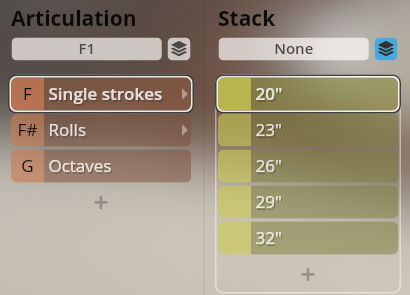
Celesta / Glockenspiel
Single notes, mapped for keyboards with 88 keys (one octave lower than sounding) and loco.
- Range
- celesta 88 keys C2–F7, loco C3–F8
- glockenspiel C4–E7, C5–E8
- 88 keys/loco: A0–B0
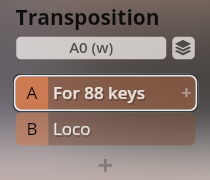
Xylophone
Single notes.
- Range: C4–C8
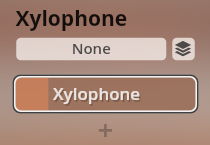
Tubular Bells
Single notes.
- Range: F3–F5
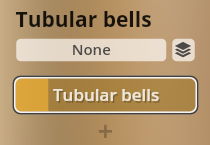
Snare Drum
Single hits offcenter (normal) and rim, press rolls, rimshots, and rolls. The two articulation slots are stacked so that they can be played without keyswitching.
- Range: C3–C6
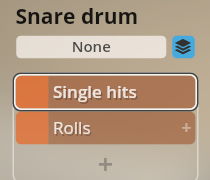
Mapping
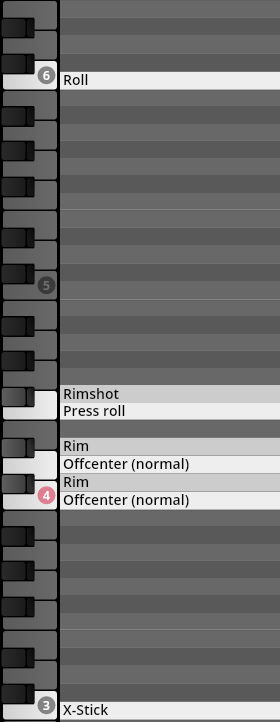
Bass Drum
Single hits normal and with muted release, and rolls with long and muted release. The two articulation slots are stacked so that they can be played without keyswitching.
- Range: C4–C6
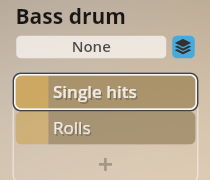
Mapping
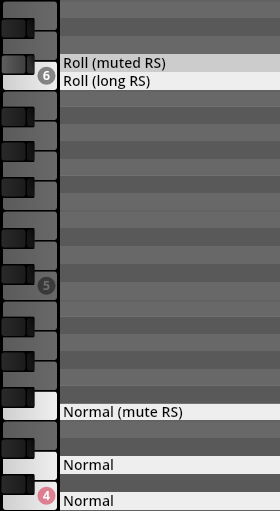
Tambourine
Single hits center and rim, shaken and thumb tremolos. The two articulation slots are stacked so that they can be played without keyswitching.
- Range: C4–C6
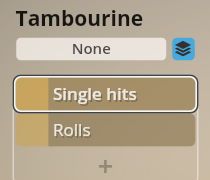
Mapping
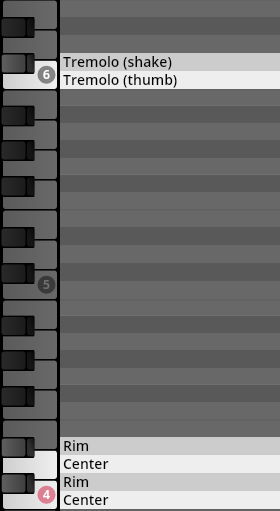
Concert Toms
Concert toms of 16", 14", and 10" diameters, with single hits normal and rim, rolls, and rimshots. The instruments and articulation slots are stacked so that they can be played without keyswitching.
- Range: C3–F#5
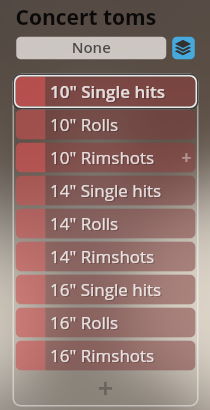
Mapping
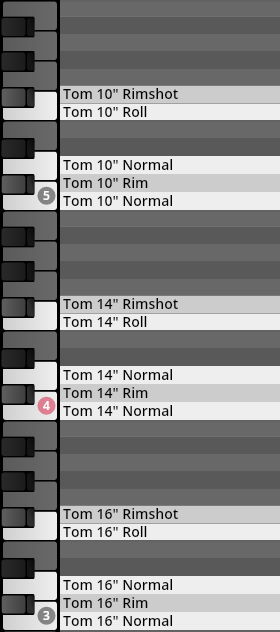
Taiko
A large taiko drum (odaiko) with 53" diameter, played with the traditional bachi on center and rim, and with a soft beater.
- Range: C4–D5
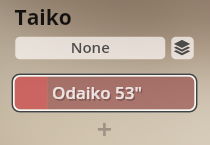
Mapping
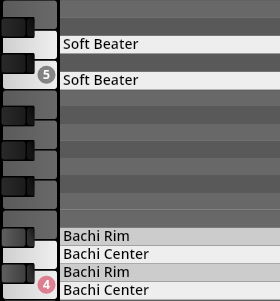
Piatti
20" piatti: normal and muted strokes, and strokes with additional release samples.
- Range: C4–F4
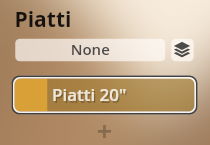
Mapping
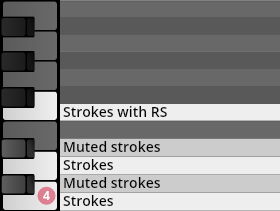
Suspended Cymbal
The suspended cymbal ist played with sticks and soft mallets.
Sticks: top and edge strokes (regular and with additional release samples), top and edge rolls with long and short release.
- Soft mallets: single hits and roll
- Range
- sticks C4–D#6
- soft mallets C4–C6
- Beater switches: C1/D1
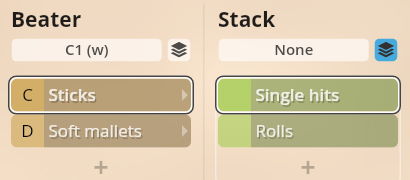
Mapping - sticks
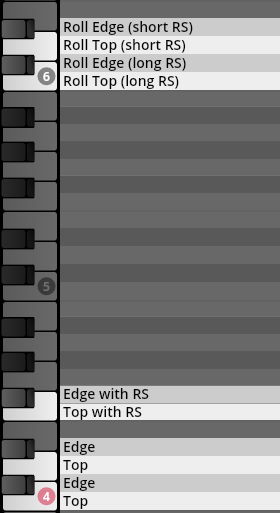
Mapping - soft mallets
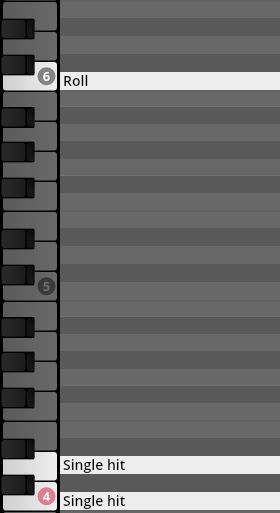
Tam-tam
Single strokes normal and muted as well as with additional release samples, and rolls with long and short release. The two articulation slots are stacked so that they can be played without keyswitching.
- Range: C4–C#6
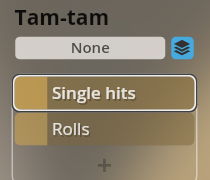
Mapping
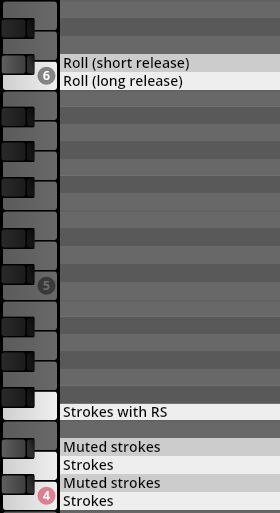
Triangle
Single strokes open (also with additional release samples) and closed, and rolls with long and short release. The two articulation slots are stacked so that they can be played without keyswitching.
- Range: C4–C#6
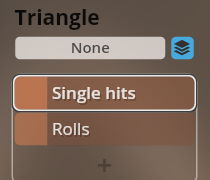
Mapping
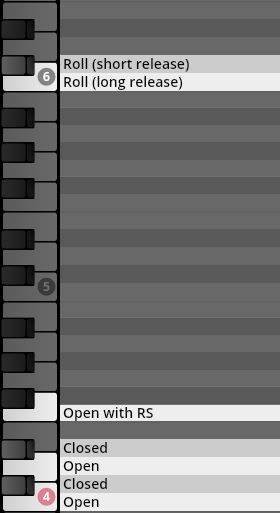
Woodblocks
Three woodblocks of different sizes, with single hits on center and rim, and rolls. The instruments and articulation slots are stacked so that they can be played without keyswitching.
- Range: C3–E5
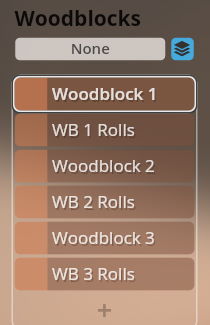
Mapping
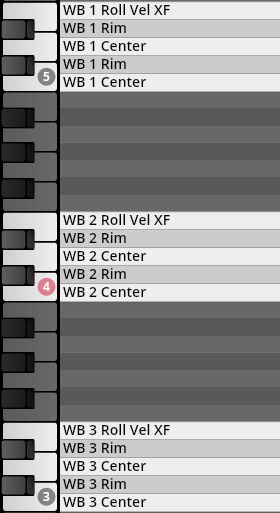
Unpitched
In this special preset, the unpitched percussion instruments are stacked so that you can access them without keyswitching.
- Range: C1–C8
- Bass drum: C1–E1
- Taiko: F1–B1
- Concert tom 16": C2–E2
- Concert tom 14": G2–B2
- Concert tom 10": C3–E3
- Snare: F3–B3
- Tambourine: C4–F4
- Tam-tam: F#4–B4
- Cymbal stick: C5–G#5
- Cymbal mallet: A5–B5
- Piatti: C6–E6
- Triangle: F6–B6
- Woodblock 3: C7–D#7
- Woodblock 2: F7–G#7
- Woodblock 1: A7–C8
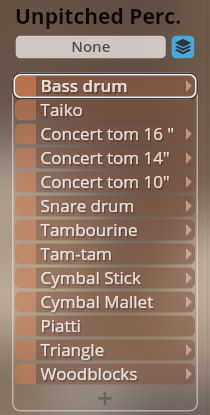
Mapping

